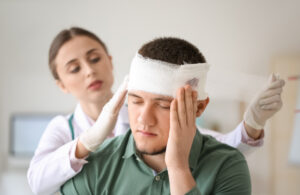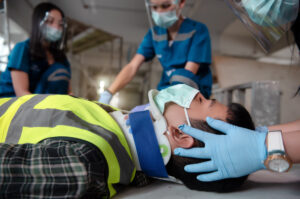Understanding and Responding to Head Injuries
Head injuries range from mild bumps to serious brain trauma. Recognizing the signs and knowing how to respond could save lives.
Immediate Actions for Head Injuries
When you encounter someone with a head injury, first ensure safety for both the injured and yourself. Always be vigilant for potential spinal injuries, particularly if the nature of the accident suggests such a risk.
Evaluating Consciousness
Assessing the victim’s level of consciousness is crucial. The AVPU scale—Alert, Voice, Pain, Unresponsive—helps determine the appropriate response:
- Alert: Is the person fully alert? Check if they can open their eyes and respond coherently.
- Voice: Can they respond to being spoken to? Note their ability to understand and answer questions.
- Pain: Do they react to painful stimuli? This could involve a gentle pinch to see if there’s a response.
- Unresponsive: If there is no reaction to voice or pain, immediate medical action is required.
Types of Head Injuries
Head injuries can vary greatly in severity:
- Concussion: This is the most common type of traumatic brain injury. Symptoms range from headache and confusion to dizziness and ringing in the ears.
- Cerebral Compression: This serious condition involves pressure on the brain caused by swelling or bleeding. Immediate medical attention is critical to relieve pressure and prevent further damage.
- Cerebral Contusion: Similar to bruises on other parts of the body, this involves bleeding under the skin of the brain. Symptoms vary based on the contusion’s location.
- Skull Fractures: These are breaks in the skull bone. They might present with clear fluid or blood from the nose or ears, a sign of potential brain injury.
Treatment of Head Injuries
Providing the right first aid for head injuries involves several critical steps:
- Move the person to a safe area if necessary, being careful not to aggravate potential spinal injuries.
- If the person is conscious, help them to a semi-upright position to reduce intracranial pressure.
- Monitor their breathing and consciousness closely.
- Avoid giving them food or drink, as surgery might be required.
- Contact emergency services immediately. Provide them with detailed information about the injury and the person’s current condition.
Monitoring and Aftercare
After the initial response, continuous monitoring is essential. Document all observations and any changes in the person’s condition. Regular reassessments can inform emergency responders upon their arrival and aid in subsequent medical treatment.
Understanding the signs and treatment of head injuries and taking swift action can significantly affect the outcome. Be prepared to provide necessary first aid and seek professional medical help without delay.



Leave a Reply